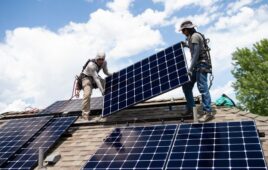Eversource Energy, the Low-Income Weatherization and Fuel Assistance Program Network, Nexamp, Vote Solar, the City of New Bedford, People Acting in Community Endeavors and National Consumer Law Center have all signed on to comments submitted to the Department of Energy Resources Monday supporting revisions to the guidelines for solar sited in low-income communities. The diverse interests represented by these groups demonstrates the clear need to bring solar energy to low-income families.
“Low-income families represent about 30% of residential customers in Massachusetts, but only 3% of recent solar customers. These families carry the largest energy burden, especially during this pandemic, and would benefit most from electric bill savings from solar. That’s a huge opportunity gap,” said Nathan Phelps, Northeast Regulatory Director at Vote Solar. “Our proposed changes to the solar guidelines will help close the gap and bring energy savings to more Massachusetts families.”
Low-income customers in Massachusetts have the highest energy burden of any electric customers in the commonwealth, meaning they spend a higher percentage of their income on their electric bill. As a result, these customers have the most to gain from solar savings. Unfortunately, to date less than 3% of solar projects entering the commonwealth’s current solar program, Solar Massachusetts Renewable Target (SMART), will serve low-income families.
The joint proposal charges the Low-Income Weatherization and Fuel Assistance Program Network, which includes Community Action Programs, with identifying and enrolling eligible families. In addition, it gives them the tools to partner with solar developers to offer savings to low-income families with no financial obligation.
“We are already in touch with every low-income Bay Stater who could benefit from solar savings,” said the Low-Income Weatherization and Fuel Assistance Program Network. “So we will ensure these benefits reach the right families without adding costs and bureaucracy, or invading the privacy of the families we serve.”
The proposal allocates a portion of the financial incentives from SMART to the solar developer, eliminating the need for billing the customer. The customer gets savings on their electric bill and the developer is paid directly by the utility. This reduces transaction costs for everyone and provides customers with iron-clad consumer protection.
“Ensuring the benefits of clean energy are accessible to all our customers, including traditionally underserved communities, is a priority for us,” said Eversource Customer Solar Program Director Andrew Belden.“These proposed changes will make it easier for low-income customers to benefit from the SMART program while also guaranteeing customer savings.”
In April, the Massachusetts Department of Energy Resources issued new regulations for the Solar Massachusetts Renewable Target (SMART), expanding the incentive program to help drive enough solar to power the equivalent of more than 250,000 homes. These guidelines will help the agency implement the updated rules, which require that 5% of the additional capacity serves low-income households.
“As solar energy increases in adoption and availability, we have to ensure that the benefits are shared equitably across all demographics,” notedZaid Ashai, CEO, Nexamp. “Clean energy cannot be a privilege for the few, but rather should be a right for all. This proposal represents the best opportunity to guarantee the SMART program reaches all Massachusetts households by streamlining the process of identifying and enrolling low-income families in community solar projects. Massachusetts can and must take a leadership role in democratizing solar. This aligns with Nexamp’s mission and we are proud to be advocating for this important change.”
News item from Vote Solar





Tell Us What You Think!